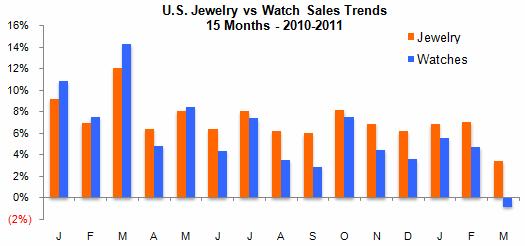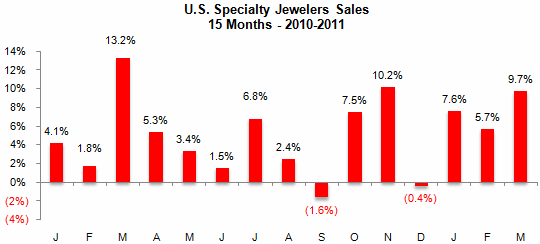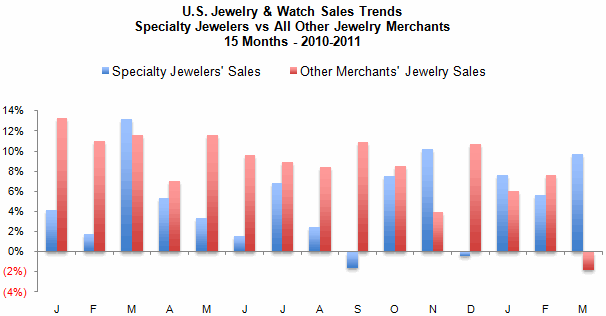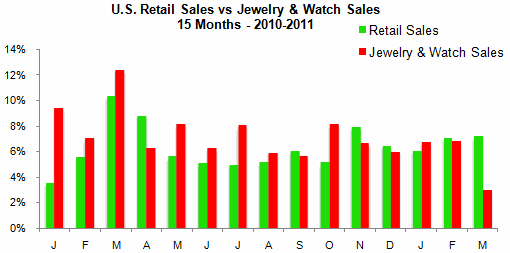IDEX Online Research: U.S. Jewelry Sales Gains Greater Than Watch Sales Gains
May 16, 11
(IDEX Online) - Jewelry sales in March showed a greater gain than watch sales, which lost ground. Jewelry sales gains have consistently been greater than watch sales gains every year since 2004.
Last month, we reported that watch sales in February outpaced jewelry sales gains, based on preliminary data. Now that the sales data has gone through one revision (with more to come, though of a much more modest magnitude), it appears that jewelry sales in February actually outpaced watch sales, continuing the historical trend. We had noted in our report last month that “[w]e believe that this is probably an anomaly related to the preliminary numbers.” In fact, that was the case.
Total jewelry and watch sales were an estimated $4.4 billion in March 2011, up from the prior year’s estimated $4.3 billion. March’s monthly sales of $4.4 billion were more or less in line with other months in 2010 which did not have a major sales event driving demand such as Valentine’s, Mother’s Day, or Christmas.
Jewelry (only) sales represent about 89% of total industry sales, or an estimated $3.9 billion in March 2011.
The graph summarizes monthly changes in sales for jewelry (red bar) and watches (blue bar) over the past fifteen months.

Source: US Dept of Commerce
Specialty Jewelers’ March Sales Show Dramatic Gain
Specialty jewelers posted a high single-digit gain of 9.7% in March, based on the preliminary data. Despite a major revision to specialty jewelers’ sales data, we believe that this is an anomaly, and will be revised downward in the next reporting cycle. This is one of the largest gains in the recovery cycle. Even more interestingly, it is against a very difficult 13% gain in March 2010. In short, this number is “suspect.”
In March, specialty jewelers’ sales were about $2.0 billion, up from last year’s $1.8 billion.
The graph below summarizes fifteen months of sales trends for specialty jewelers in the U.S. market.

Source: US Dept of Commerce
Specialty Jewelers Gain Market Share From Competitors
For more than three decades, specialty jewelers have been losing market share to other merchants who sell jewelry. Typically, specialty jewelers lose market share in recessionary periods, and they never seem to regain this market share, even when the economy rebounds. We believe that this may be due to consumers’ quest for “value” – they believe that they can get a better deal on a day-to-day basis by shopping at discounters like Costco, Wal-Mart, and J.C. Penney than at specialty jewelers. An analysis of gross margins suggests that specialty jewelers tend to mark up their prices more than discounters and online merchants.
However, in March, specialty jewelers in the U.S. took market share from other retailers who sell jewelry.
The graph below summarizes specialty jewelers’ sales versus jewelry sales at other merchants. Like January, the month of March was also an exception to the long term trend – specialty jewelers took market share.
Specialty jewelers’ sales are shown by the blue bars, while other merchants’ jewelry sales are represented by the red bars.

Source: US Dept of Commerce
Jewelry Lost Share of Wallet in March
Jewelry lost a modest share of consumer expenditures – also called “share of wallet” – in March, based on preliminary numbers. Longer term, we expect this trend to reverse: jewelry represents an industry with solid growth prospects, both in the U.S. and overseas, especially in markets in China and India. We believe that revised March data (likely to come later this summer) will show that jewelry took market share from other retail categories.
The graph below compares retail sales gains (ex-auto) to jewelry sales trends. Retail sales are show by the green bars, while jewelry and watch sales are represented by the red bars.

Source: US Dept of Commerce